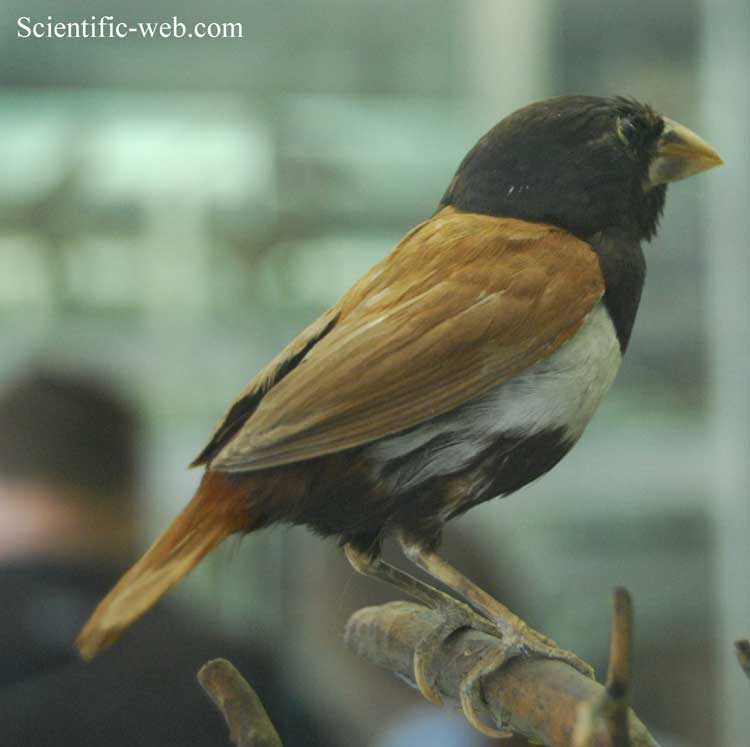
Lonchura atricapilla, Photo: Michael Lahanas
Superregnum: Eukaryota
Cladus: Unikonta
Cladus: Opisthokonta
Cladus: Holozoa
Regnum: Animalia
Subregnum: Eumetazoa
Cladus: Bilateria
Cladus: Nephrozoa
Superphylum: Deuterostomia
Phylum: Chordata
Subphylum: Vertebrata
Infraphylum: Gnathostomata
Megaclassis: Osteichthyes
Cladus: Sarcopterygii
Cladus: Rhipidistia
Cladus: Tetrapodomorpha
Cladus: Eotetrapodiformes
Cladus: Elpistostegalia
Superclassis: Tetrapoda
Cladus: Reptiliomorpha
Cladus: Amniota
Classis: Reptilia
Cladus: Eureptilia
Cladus: Romeriida
Subclassis: Diapsida
Cladus: Sauria
Infraclassis: Archosauromorpha
Cladus: Crurotarsi
Divisio: Archosauria
Cladus: Avemetatarsalia
Cladus: Ornithodira
Subtaxon: Dinosauromorpha
Cladus: Dinosauriformes
Cladus: Dracohors
Cladus: Dinosauria
Ordo: Saurischia
Cladus: Eusaurischia
Subordo: Theropoda
Cladus: Neotheropoda
Cladus: Averostra
Cladus: Tetanurae
Cladus: Avetheropoda
Cladus: Coelurosauria
Cladus: Tyrannoraptora
Cladus: Maniraptoromorpha
Cladus: Maniraptoriformes
Cladus: Maniraptora
Cladus: Pennaraptora
Cladus: Paraves
Cladus: Eumaniraptora
Cladus: Avialae
Infraclassis: Aves
Cladus: Avebrevicauda
Cladus: Pygostylia
Cladus: Ornithothoraces
Cladus: Ornithuromorpha
Cladus: Carinatae
Parvclassis: Neornithes
Cohors: Neognathae
Cladus: Neoaves
Cladus: Telluraves
Cladus: Australaves
Ordo: Passeriformes
Subordo: Passeri
Infraordo: Passerida
Superfamilia: Passeroidea
Familia: Estrildidae
Genus: Lonchura
Species: Lonchura atricapilla
Subspecies: L. a. atricapilla – L. a. batakana – L. a. brunneiceps – L. a. deignani – L. a. formosana – L. a. jagori – L. a. obscura – L. a. selimbaue – L. a. sinensis
Name
Lonchura atricapilla (Vieillot, 1807)
Synonyms
Loxia atricapilla (protonym)
Lonchura malacca atricapilla (Vieillot, 1807)
References
Vieillot, L.P. 1805. Histoire naturelle des plus beaux oiseaux chanteurs de la zone torride. 112 pp. + 70 tt. Dufour, Paris. BHL Reference page. p. 84 pl. 53
Vernacular names
English: Southern black-headed munia
español: Capuchino castaño
The chestnut munia or black-headed munia (Lonchura atricapilla) is a small passerine. It was formerly considered conspecific with the closely related tricoloured munia, but is now widely recognized as a separate species. This estrildid finch is a resident breeding bird in Bangladesh, Brunei, Cambodia, China, India, Indonesia, Laos, Malaysia, Burma, Nepal, the Philippines, Singapore, Taiwan, Thailand, Vietnam and Hawaii. It also has been introduced to all the Greater Antilles and Martinique in the Caribbean.
Before 1995, it was the national bird of the Philippines,[2] where it is known as mayang pula ("red maya") because of its brick red patch on the lower back which is visible only when it flies. (This distinguishes it from other birds locally called maya, notably the predominantly brownish "mayang simbahan" (tree sparrow)[3] which is more common in urban areas.)
Subspecies
The chestnut munia has several subspecies that are recognized, including:
Lonchura atricapilla atricapilla
Lonchura atricapilla rubroniger
Lonchura atricapilla sinensis
Lonchura atricapilla formosana
Lonchura atricapilla deignani
Lonchura atricapilla brunneiceps
Lonchura atricapilla jagori
Lonchura atricapilla selimbauensis
Lonchura atricapilla obscura
Lonchura atricapilla batakana
Description
Chestnut Munia in Azara, Assam
Small, sexes alike, races differ slightly in intensity of color. in jagori Ad whole head, breast center of belly, and undertail coverts black; back, wing, and sides of belly chestnut, brighter on underparts, duller on wings; uppertail coverts dark reddish brown, underpart buff; uppertail coverts and tail as ad. Bill silvery gray; eye chestnut; legs gray.
Habitat
Adult
Chestnut munia nest. Nest is dome-shaped; entrance/exit point is visible
The chestnut munia is a small gregarious bird which feeds mainly on grain and other seeds. It frequents open grassland and cultivation. The nest is a large domed grass structure in a bush or tall grass into which 4-7 white eggs are laid.
Characteristics
Adult
The chestnut munia is 11–12 cm in length. The adult has a stubby pale grey-blue bill, black head, and brown body, with a brick red patch on the lower back, visible only when it flies. Some races also have a black belly.
The sexes are similar, but immature birds have uniform pale brown upperparts, lack the dark head and have white to pale buff underparts.
National bird of the Philippines until 1995
The black-headed munia was the national bird of the Philippines[2] until 1995, when that honorific was transferred to the Philippine eagle. There, due to urbanization and the resulting lack of awareness of local species, it is nowadays often confused for the Eurasian tree sparrow because that species, one of several also categorized as "maya" in the Philippines, is much more common in the urban areas.[2][3]
References
A Guide to the birds of the Philippines(2000) Robert S. Kennedy pedro C. Gonzales, Edward C, Dickinson Hector C. Miranda, jr. & Timothy H. Fisher
Birds of India by Grimmett, Inskipp and Inskipp, ISBN 0-691-04910-6
Munias and Mannikins by Robin Restall, ISBN 1-873403-51-8
BirdLife International (2016). "Lonchura atricapilla". IUCN Red List of Threatened Species. 2016: e.T22729138A95007301. doi:10.2305/IUCN.UK.2016-3.RLTS.T22729138A95007301.en. Retrieved 12 November 2021.
Kennedy, Robert; et al. (21 September 2000). A Guide to the Birds of the Philippines. OUP Oxford. ISBN 0-19-854668-8.
"10 Most Common Urban Birds". 2 July 2013.
Retrieved from "http://en.wikipedia.org/"
All text is available under the terms of the GNU Free Documentation License

